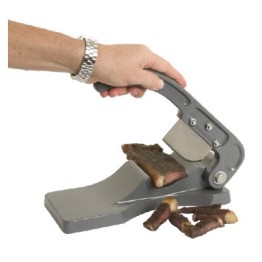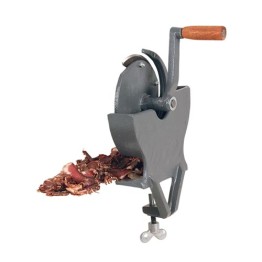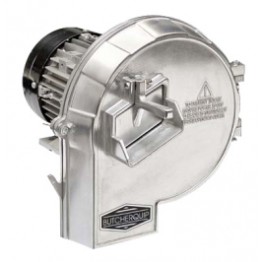Biltong Slicers

Biltong Slicers
Discover the ultimate tool for biltong lovers - biltong slicers. These ingenious gadgets make slicing your favourite air-dried meat a breeze, ensuring perfectly thin, even slices every time. Whether you're a biltong connoisseur or simply enjoy a tasty snack, a biltong slicer is a must-have addition to your kitchen.
Gone are the days of struggling with a knife and ending up with uneven chunks or wasting precious biltong by slicing too thick. With a biltong slicer, you can effortlessly achieve the ideal thickness and consistency, allowing you to fully enjoy the flavours and textures of this popular South African delicacy.
Designed with precision and convenience in mind, biltong slicers are easy to use, clean, and maintain. Their sharp blades effortlessly glide through the meat, ensuring a clean cut every time. Plus, they are compact and lightweight, making them perfect for both home kitchens and outdoor adventures.
Investing in a biltong slicer not only enhances your biltong experience but also saves you time and effort. So why settle for less when you can effortlessly enjoy perfectly sliced biltong at your convenience? Upgrade your slicing game and indulge in the mouthwatering world of biltong today.
What is Biltong?
Biltong is a form of dried, cured meat that originated in South Africa. It is a beloved snack that has gained popularity worldwide due to its rich flavour and high protein content. Typically made from beef, biltong is marinated, spiced, and air-dried for several days before it is ready to consume.The process of making biltong involves cutting meat into strips, curing it with a blend of vinegar, salt, and spices, and then hanging it to dry. The result is a chewy, flavourful snack that can be enjoyed on its own or added to various dishes for an extra kick of flavour.
Unlike jerky, which is often smoked and has a different texture, biltong retains a unique taste profile due to its distinct preparation process. It's also commonly found in various thicknesses and textures, ranging from soft and chewy to hard and brittle, depending on personal preference and the duration of the drying process.
The History of Biltong Slicers
The need for biltong slicers arose from the traditional method of preparing biltong, which was a laborious and time-consuming task. Initially, biltong was sliced by hand using knives, which could be inefficient and inconsistent, leading to a variety of slice sizes and thicknesses.The development of biltong slicers can be traced back to the desire to standardise the slicing process and improve the overall experience of enjoying this savoury treat. Inventors and craftsmen sought to create a tool that could handle the tough, dried meat with ease, while delivering uniform slices that showcase biltong at its best.
From simple manual slicers to more advanced electric models, the evolution of biltong slicers has mirrored the growing popularity of the snack itself. Innovations have been driven by the pursuit of convenience, efficiency, and the desire to provide the optimal way to prepare biltong for consumption.
Benefits of Using a Biltong Slicer
A biltong slicer offers a multitude of benefits over the traditional knife-cutting method. Firstly, it provides uniformity in slice thickness, which is crucial for consistent flavour and texture, as well as aesthetic appeal when serving.Moreover, a biltong slicer is designed to handle the tough consistency of dried meat, which can be challenging to cut through with a regular knife. This makes the slicing process much smoother and less strenuous, which is particularly beneficial for those who prepare large quantities of biltong.
Using a biltong slicer also reduces the risk of injury. The sharp, precise blades are safely enclosed, minimising the chance of cuts that can occur when manually slicing with a knife. Additionally, slicers are typically easy to clean and maintain, ensuring that they remain hygienic and effective over time.
Types of Biltong Slicers
There are several types of biltong slicers available on the market, each catering to different needs and preferences. The most common types are manual slicers, which usually feature a clamp to secure the biltong in place and a handle to operate the blade.Electric biltong slicers are another popular option, favoured for their ease of use and ability to slice through meat quickly and efficiently. These are especially suitable for individuals who frequently consume biltong or for commercial use in shops or restaurants.
For those who enjoy the ritual of preparing biltong, there are also more traditional, artisanal slicers made from materials like hardwood and stainless steel. These often feature hand-crafted designs and can serve as a stylish addition to one's kitchenware collection.
Factors to Consider When Choosing a Biltong Slicer
When selecting a biltong slicer, there are several factors to take into account to ensure you choose the right one for your needs. The quality of the blade is paramount – it should be made from high-grade stainless steel to maintain sharpness and resist corrosion.The safety features of the slicer should not be overlooked. Look for slicers with non-slip feet, safety guards, and a comfortable grip to ensure a secure slicing process. The size and portability might also be considerations, particularly for those who travel or enjoy outdoor activities.
Lastly, consider the ease of cleaning. Since biltong can be oily and leave residue, a slicer that is simple to disassemble and clean will save time and effort, while also preventing the buildup of bacteria.
How to Use a Biltong Slicer
Using a biltong slicer is straightforward, but it's important to follow the correct procedure to achieve the best results. Start by securing the biltong in the slicer, ensuring it is clamped down firmly if you're using a manual model.For manual slicers, use the handle to move the blade through the meat in a smooth, controlled motion. If you're using an electric slicer, simply feed the biltong into the machine and let the slicer do the work for you.
Always slice biltong against the grain for the best texture. Adjust the thickness setting according to your preference, and proceed with slicing the rest of the biltong in a consistent manner for even slices.
Cleaning and Maintenance of a Biltong Slicer
Keeping your biltong slicer clean is essential for both hygiene and functionality. After each use, remove any meat residue from the blade and body of the slicer. Most slicers have components that are detachable for thorough cleaning.Wash the detachable parts in warm, soapy water, and be sure to dry them completely before reassembling the slicer to prevent rust or mould from forming. For electric slicers, ensure that no water gets into the electrical components.
Regular maintenance may also include sharpening the blade to ensure it remains effective. Some slicers come with blade sharpeners or instructions on how to maintain the cutting edge. Always refer to the manufacturer's guidelines for specific care instructions.
Popular Brands of Biltong Slicers
There are several reputable brands that produce high-quality biltong slicers. Some of the most popular include Butcherquip, Mellerware, and Boska, known for their durable construction and precision slicing.Each brand offers a range of models, from basic manual slicers to more sophisticated electric ones. These brands often feature ergonomic designs and innovative features, such as adjustable thickness settings and easy-to-clean components.
When choosing a brand, consider the warranty and customer service support offered, as this can provide peace of mind and assistance in the event of any issues with your slicer.
Where to Buy Biltong Slicers
Biltong slicers can be purchased from a variety of outlets. Kitchenware shops, specialty gourmet stores, and online retailers are common places where you can find a wide selection of slicers.Online marketplaces like Amazon and eBay offer the convenience of home delivery and often provide customer reviews that can help inform your decision. Additionally, purchasing directly from the manufacturer's website can sometimes yield exclusive deals or discounts.
For those who prefer to see and handle the slicer before making a purchase, visiting a physical store can be advantageous. Staff can often provide demonstrations and answer any questions you may have.
Conclusion
Biltong slicers are an essential tool for anyone who appreciates the unique taste and texture of biltong. They provide a convenient, safe, and efficient way to enjoy this South African delicacy in the comfort of your own home.Whether you opt for a manual or electric slicer, the key is to select a model that suits your needs and budget. With the right biltong slicer, you can ensure that each slice is as delicious as the last, enhancing your snacking experience and allowing you to savour biltong to its fullest.
Remember to consider the factors discussed, such as blade quality, safety features, ease of cleaning, and brand reputation when choosing your slicer. With proper use and maintenance, your biltong slicer will serve you well for many years to come, becoming a cherished tool in your culinary arsenal.
Biltong Cutter Manual - Aluminium Cast
Biltong Cutter Manual - Aluminium Cast. Cut Biltong To Whatever Size You Prefer With This Manual Stu..
R1,058.82 R1,411.76 Ex Tax: R1,058.82
Biltong Slicer Hand Operated - Aluminium - Table Mounted
Biltong Slicer Hand Operated - Aluminium - Table Mounted. Perfect For Small Bars, Clubs, Restaurants..
R1,736.47 R2,315.29 Ex Tax: R1,736.47
Biltong Slicer – Butcherquip Electric
Biltong Slicer – Butcherquip Electric. The Cutting Discs Are Dynamically Balanced With The Blade For..
R5,218.82 R6,958.43 Ex Tax: R5,218.82
[Discontinued] Biltong Slicer Hand Operated Chunk Slicer - Table
Biltong Slicer Hand Operated Chunk Slicer - Table Mounted. Sturdy Table Mounted Slicer Designed For ..
R0.00 Ex Tax: R0.00
Showing 1 to 4 of 4 (1 Pages)




![[Discontinued] Biltong Slicer Hand Operated Chunk Slicer - Table [Discontinued] Biltong Slicer Hand Operated Chunk Slicer - Table](https://www.nationalcatering.co.za/image/cache/catalog/BSH2005-262x262.jpg)